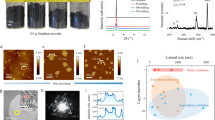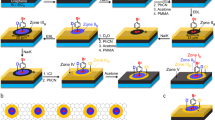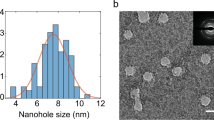Abstract
The processability of giant (macro)molecules into ultrapure and highly ordered structures at surfaces is of fundamental importance for studying chemical, physical and biological phenomena, as well as their exploitation as active units in the fabrication of hybrid devices1,2. The possibility of handling larger and larger molecules provides access to increasingly complex functions3,4,5,6. Unfortunately, larger molecules commonly imply lower processability due to either their low solubility in liquid media or the occurrence of thermal cracking during vacuum sublimation. The search for novel strategies to process and characterize giant building blocks is therefore a crucial goal in materials science. Here we describe a new general route to process, at surfaces, extraordinarily large molecules, that is, synthetic nanographenes7, into ultrapure crystalline architectures. Our method relies on the soft-landing of ions8 generated by solvent-free matrix-assisted laser desorption/ionization (MALDI). The nanographenes are transferred to the gas phase, purified and adsorbed at surfaces. Scanning tunnelling microscopy reveals the formation of ordered nanoscale semiconducting supramolecular architectures. The unique flexibility of this approach allows the growth of ultrapure crystalline films of various systems, including organic, inorganic and biological molecules, and therefore it can be of interest for technological applications in the fields of electronics, (bio)catalysis and nanomedicine.
This is a preview of subscription content, access via your institution
Access options
Subscribe to this journal
Receive 12 print issues and online access
$259.00 per year
only $21.58 per issue
Buy this article
- Purchase on Springer Link
- Instant access to full article PDF
Prices may be subject to local taxes which are calculated during checkout



Similar content being viewed by others
References
Alivisatos, A. P. et al. From molecules to materials: Current trends and future directions. Adv. Mater. 10, 1297–1336 (1998).
Vriezema, D. M. et al. Self-assembled nanoreactors. Chem. Rev. 105, 1445–1489 (2005).
Supramolecular chemistry and self-assembly. Science 295 (special issue) 2395–2421 (2002).
Martin, R. E., Mader, T. & Diederich, F. Monodisperse poly(triacetylene) rods: Synthesis of a 11.9 nm long molecular wire and direct determination of the effective conjugation length by UV/Vis and Raman spectroscopies. Angew. Chem. Int. Edn 38, 817–821 (1999).
Balzani, V., Credi, A., Raymo, F. M. & Stoddart, J. F. Artificial molecular machines. Angew. Chem. Int. Edn 39, 3349–3391 (2000).
Van der Auweraer, M. & De Schryver, F. C. Organic electronics: Supra solutions. Nature Mater. 3, 507–508 (2004).
Watson, M. D., Fechtenkötter, A. & Müllen, K. Big is beautiful—“Aromaticity” revisited from the viewpoint of macromolecular and supramolecular benzene chemistry. Chem. Rev. 101, 1267–1300 (2001).
Franchetti, V., Solka, B. H., Baitinger, W. E., Amy, J. W. & Cooks, R. G. Soft landing of ions as a means of surface modification. Int. J. Mass. Spectrom. Ion. Phys. 23, 29–35 (1977).
Tsekouras, A. A., Iedema, M. J. & Cowin, J. P. Soft-landed ion diffusion studies on vapor-deposited hydrocarbon films. J. Chem. Phys. 111, 2222–2234 (1999).
Ouyang, Z. et al. Preparing protein microarrays by soft-landing of mass-selected ions. Science 301, 1351–1354 (2003).
Feng, B. B., Wunschel, D. S., Masselon, C. D., Pasa-Tolic, L. & Smith, R. D. Retrieval of DNA using soft-landing after mass analysis by ESI-FTICR for enzymatic manipulation. J. Am. Chem. Soc. 121, 8961–8962 (1999).
Gologan, B. et al. Ion soft-landing into liquids: Protein identification, separation and purification with retention of biological activity. J. Am. Soc. Mass Spectrom. 15, 1874–1884 (2004).
Miller, S. A., Luo, H., Pachuta, S. J. & Cooks, R. G. Soft-landing of polyatomic ions at fluorinated self-assembled monolayer surfaces. Science 275, 1447–1450 (1997).
Schriemer, D. C. & Li, L. Detection of high molecular weight narrow polydisperse polymers up to 1.5 million Daltons by MALDI mass spectrometry. Anal. Chem. 68, 2721–2725 (1996).
Gologan, B., Green, J. R., Alvarez, J., Laskin, J. & Cooks, R. G. Ion/surface reactions and ion soft-landing. Phys. Chem. Chem. Phys. 7, 1490–1500 (2005).
Trimpin, S., Rouhanipour, A., Az, R., Räder, H. J. & Müllen, K. Rapid Commun. Mass Spectrom. 15, 1364–1373 (2001).
Przybilla, L., Brand, J. D., Yoshimura, K., Räder, H. J. & Müllen, K. MALDI-TOF mass spectrometry of insoluble giant polycyclic aromatic hydrocarbons by a new method of sample preparation. Anal. Chem. 72, 4591–4597 (2000).
Jurchescu, O. D., Baas, J. & Palstra, T. T. M. Effect of impurities on the mobility of single crystal pentacene. Appl. Phys. Lett. 84, 3061–3063 (2004).
Samorì, P., Severin, N., Simpson, C. D., Müllen, K. & Rabe, J. P. Epitaxial composite layers of electron donors and acceptors from very large polycyclic aromatic hydrocarbons. J. Am. Chem. Soc. 124, 9454–9457 (2002).
Schmitz-Hübsch, T. et al. Direct observation of organic-organic heteroepitaxy: perylene-tetracarboxylic-dianhydride on hexa-peri-benzocoronene on highly ordered pyrolytic graphite. Surf. Sci. 445, 358–367 (2000).
van de Craats, A. M. & Warman, J. M. The core-size effect on the mobility of charge in discotic liquid crystalline materials. Adv. Mater. 13, 130–133 (2001).
Brédas, J. L., Calbert, J. P., da Silva, D. A. & Cornil, J. Organic semiconductors: A theoretical characterization of the basic parameters governing charge transport. Proc. Natl Acad. Sci. USA 99, 5804–5809 (2002).
Schmidt-Mende, L. et al. Self-organized discotic liquid crystals for high-efficiency organic photovoltaics. Science 293, 1119–1122 (2001).
Cousty, J. & Van, L. P. Formation of partially demixed two-dimensional solid solutions from binary mixtures of n-alkanes with very different lengths. Phys. Chem. Chem. Phys. 5, 599–603 (2003).
Goddard, R., Haenel, M. W., Herndon, W. C., Kruger, C. & Zander, M. Crystallization of large planar polycyclic aromatic-hydrocarbons—the molecular and crystal-structures of hexabenzo[bc, ef, hi, kl, no, qr]coronene and benzo[1,2,3-bc/4,5,6-b′c′ ]dicoronene. J. Am. Chem. Soc. 117, 30–41 (1995).
Samorì, P. et al. Self-assembly and manipulation of crown ether phthalocyanines at the gel-graphite interface. Angew. Chem. Int. Edn 40, 2348–2350 (2001).
Samorì, P. et al. Growth of ordered hexakis-dodecyl-hexabenzoeoronene layers from solution: A SFM and ARUPS study. J. Phys. Chem. B 105, 11114–11119 (2001).
Friedlein, R. et al. Electronic structure of highly ordered films of self-assembled graphitic nanocolumns. Phys. Rev. B 68, 195414 (2003).
Pisula, W. et al. A zone-casting technique for device fabrication of field-effect transistors based on discotic hexa-peri-haxabenzocoronene. Adv. Mater. 17, 684–689 (2005).
Sirringhaus, H. et al. Two-dimensional charge transport in self-organized, high-mobility conjugated polymers. Nature 401, 685–688 (1999).
Kaleta, D. T. & Jarrold, M. F. Helix-turn-helix motifs in unsolvated peptides. J. Am. Chem. Soc. 125, 7186–7187 (2003).
Acknowledgements
We thank T. Jung for enlightening discussions and D. Jones for his comments on the manuscript. We acknowledge financial support from ESF-SONS-BIONICS, the EU through the Marie Curie EST-SUPER (MEST-CT-2004-008128) and the IP-NAIMO (NMP4-CT-2004-500355), as well as Emilia Romagna-Consorzio Spinner (TT-NANOSMILE grant).
Author information
Authors and Affiliations
Corresponding authors
Ethics declarations
Competing interests
The authors declare no competing financial interests.
Supplementary information
Supplementary information
Supplementary information and figures S1, S2 (PDF 174 kb)
Rights and permissions
About this article
Cite this article
Räder, H., Rouhanipour, A., Talarico, A. et al. Processing of giant graphene molecules by soft-landing mass spectrometry. Nature Mater 5, 276–280 (2006). https://doi.org/10.1038/nmat1597
Received:
Accepted:
Published:
Issue Date:
DOI: https://doi.org/10.1038/nmat1597
This article is cited by
-
Self-organizing layers from complex molecular anions
Nature Communications (2018)
-
Large-scale solution synthesis of narrow graphene nanoribbons
Nature Communications (2014)
-
All-carbon sp-sp2 hybrid structures: Geometrical properties, current rectification and current amplification
Scientific Reports (2013)
-
Partial sequencing of a single DNA molecule with a scanning tunnelling microscope
Nature Nanotechnology (2009)
-
Large-area bi-component processing of organic semiconductors by spray deposition and spin coating with orthogonal solvents
Applied Physics A (2009)



